its paid sponsors, whose products you need!
“Stay ‘unreasonable.’ If you
don’t like the solutions [available to you], come up with your
own.”
Dan Webre
The Martialist does not
constitute legal advice. It is for ENTERTAINMENT
PURPOSES ONLY.
Copyright © 2003-2004 Phil Elmore, all rights
reserved.
Train the Stick to Learn the Blade?
By
Phil Elmore
One of those polarizing debates within the martial arts community revolves
around the question of training with sticks to learn knife and sword work.
Can one “train the stick to learn the blade?” Proponents of this idea
like the low cost and forgiving nature of sticks, as well as the benefits of
training the basics of multiple tools through one set of implements.
Critics assert that a stick is not a blade, does not handle in the same
way, and is not necessarily used identically.

The author, flanked by (tall) fellow
stick-to-blade
and Wing Chun students Al and “Evil” Scott.
Let’s take two roughly analogous weapons: the rattan stick and the
machete (or a similarly sized cut-and-thrust sword). Training with
sticks has obvious advantages over training with machetes. The sticks
cost less, are easily replaced, and present less potential for injury.
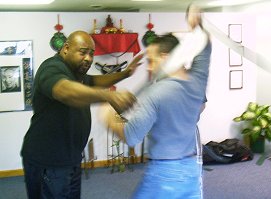 Depending
Depending
on to whom you speak, stick arts (Escrima, Arnis, whatever you want to call
them) are derived from blade arts driven underground by persecuting
conquerors. I am being deliberately vague because no two accounts I’ve
read (and no two sets of FMA argot) seem to agree completely.
Regardless, it’s true that you can do things with a stick that you cannot do
with a blade. Disarms that involve grabbing the “blade end” of the stick
or snaking in and around its length are good examples. It is theorized
that as the blade arts were practiced with sticks, they evolved and were
tailored to the specific nature of the cylindrical wooden weapons.
The way we hit with sticks and the way we strike with blades is intuitively
different. We tend, at least initially, to use more of a drawing,
slicing motion with a machete than we do with a stick. We hammer or
whack with the stick, cognizant of its blunt profile. The weapons also
weigh differently, meaning they handle and move with substantive differences.
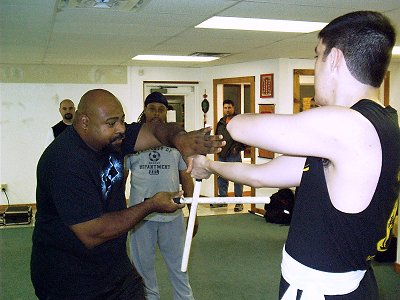
Sifu Eric Winfree (left) teaches a stick
disarm with student “Evil” Scott.
Critics of the “stick to blade” training theory will also point to edge
orientation or the lack thereof. Picture, for example, the Kendo
shinai. Students practicing sword techniques with this flexible and
cylindrical training “sword” may develop bad habits, flailing away to smack
their opponents with no real concept of their “sword’s” cutting edge.
The same problem can develop when using sticks to learn fighting with machetes
or short swords.
While there’s no denying these problems and differences exist, they can be
overcome through intent and through diligent training focused on that
intent. By remaining aware of the potential pitfalls, students of the
stick can make the transition to the blade and do so with confidence
in their methods.
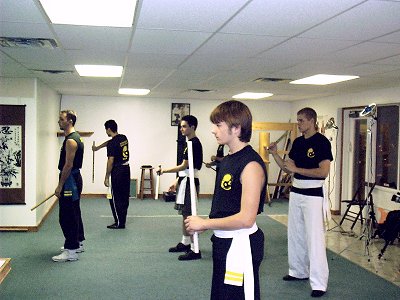
Stick training at the Syracuse Wing Chun
Academy.
Before practicing any technique, the students must ask themselves:
“Can I use this technique with a blade and do so safely? If they believe
they can, they should test the technique carefully and under proper
supervision. If they cannot, their training should be biased against
that particular technique or theory. Sifu
Eric Winfree’s Kali students, for example, regularly train with sticks and
blades, applying their stick training to machetes as shown here.
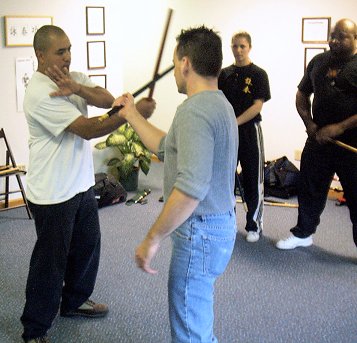
As Sifu Winfree looks on, students practice
with sticks…
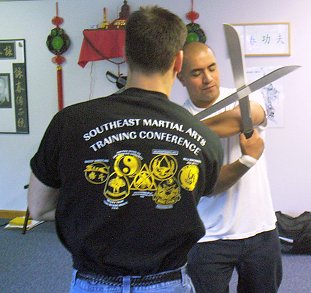
…And later make the transition to
machetes,
using the same techniques they’ve just practiced.
Diligent practice can retrain the way we strike with sticks,
replacing one’s intuitive hammering impulses with more goal-oriented
technique. A powerful hacking, slashing motion is extremely effective
with a rattan stick, imparting both snap and power. This becomes
devastating when the same technique is used with an edged weapon. With
proper snap in one’s technique, even a foam training weapon can become
quite powerful. Sifu Anthony Iglesias, armed with a foam “stick,” once
performed a witik a whipping wrist motion to strike my weapon hand.
He left a bruise. Picture doing that with wood and, better yet, with a
machete. The machete would not move as quickly, but it would move
quickly enough and do much worse damage.
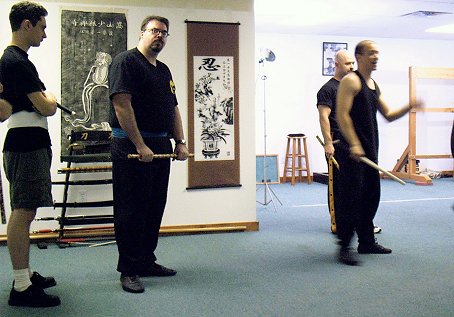
Sifu Anthony Iglesias (right) makes a point
in class.
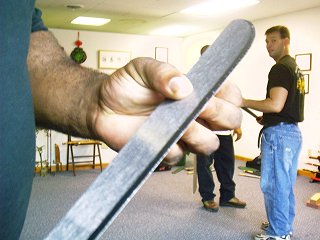 Differences
Differences
in weight do make a difference in the handling of weapons, but you must always
take this into account whenever taking up any implement. I have thick
hardwood fighting sticks that are easily as heavy as a light machete. They
handle differently than my rattan training sticks. That’s just how it
is: sticks of different materials and lengths weigh differently.
Knives and short swords weigh differently, too. I don’t believe any
serious student thinks he or she can master the blade arts while never picking
up a live weapon to do so. Training the stick to train the blade trains
the basics that these weapons platforms have in common.
Edge orientation can be trained with sticks.
Students learn to be conscious of a reference point on their hands: the
second knuckles of their fingers. They practice knowing that if their
knuckles are not properly oriented to the target, they are striking with the
“flat” of the “blade,” not the imagined edge.
There is no substitute for live blade cutting and practice to
achieve true proficiency with an edged weapon. Stick training, however,
will go a very long way towards achieving that goal. It will, in effect,
truncate the learning curve for the blade. Such training must be done
with a keen awareness of the differences across weapons platforms, of course,
and it must be done with an eye for identifying and eliminating bad habits.
Combined with judicious use of live weapons to complete the training, a “stick
to blade” curriculum helps students learn to use both categories of
weapons and to use them well.
While I understand the points made by critics of this training
theory, they must in turn understand that proponents of this idea do not
present it as the only way to learn the use of edged weapons or to
deploy those weapons in self-defense. It is, however, one sensible
way, because it capitalizes on training time and maximizes the utility of that
time. Learning one body of principles causes less confusion and makes
teaching easier and more efficient.
You can, in fact, train the stick
to learn the blade.
